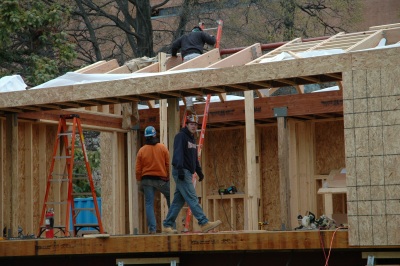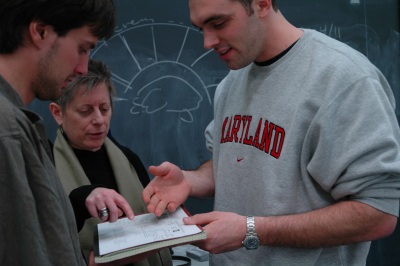
Construction workers build the LEAF House in a muddy lot behind the University of Maryland architecture building. The structure should be ready to compete against other new-age environmentally efficient homes in the fall. Photo Credit: Megan Hartley, Capital News Service.
COLLEGE PARK - On a muddy lot at the bottom of a hill near the Architecture Building here, some environmentally-conscious students are creating what they hope will be the house of the future - complete with walls made of plants and an indoor waterfall that sucks the moisture out of the air.
The project, called Leading Everyone to an Abundant Future House or "LEAF House" boasts of solar panels powering 52 batteries and floors heated by rain water. It is the brainchild of architecture, engineering and even some communication students at the University of Maryland.

From left: student Matt Caplins, professor Amy Gardner and student Tony Giampapa plan some structural elements of the LEAF house, which will compete in the Solar Decathlon - a competition to design the most attractive and efficient house. Photo Credit: Megan Hartley, Capital News Service.
"I love studying this. I consider myself an environmentalist," said senior mechanical engineering major Matt Caplins at one of the group's weekly evening meetings. "It is complex. You have to understand how much energy a structure uses over its entire lifetime, including how much energy you use to make it."
The house will compete in the Solar Decathlon - a competition sponsored by the U.S. Department of Energy - on the National Mall in Washington D.C. in the fall against 20 other universities.
Houses are judged on ten components including: comfort, appliances, lighting, architecture, engineering and market viability.
Students and professors this year hope to incorporate all the components into a house that represents the essence of Maryland and the Chesapeake Bay through the use of water.
"The house is tied to the Chesapeake Bay watershed. It is not just about being able to run off the power of the sun," said Amy Gardner, architecture professor at the University of Maryland. "It is also about main resources and how the house is connected to the site through water, gardens and landscape."
The union of architecture and engineering experts is creating some inventive components with both aesthetic and functional purposes to funnel rainwater into the home for washing and temperature control.
A "green wall" located on the south side of the house made up of potted plants will filter water to be used inside the house. Also, a waterfall inside will act as a dehumidifier, which will relieve energy pressure on the cooling system.
"I'm sure if you're a Marylander you know how humid it gets here," said Nirmal Mehta, senior electrical engineering major. "This kind of system has actually never been done before, we are inventing it.
The group plans to have gardens, including a vegetable patch, outside the house and employed a landscape architecture major to help in the plot design.
The dwelling is still in its beginning stages behind the university's architecture building. Construction workers with the help of some students who have taken a safety course are currently working on the house, which has a basic frame up so far.
When it is complete, it will take about seven hours to transport on a wide-load truck the 14 miles to the District. But that is only the beginning. Once it arrives students will have to assemble the landscape and develop demonstrations of the house's features for visitors.
This is not the only hassle facing the group of environmentally-savvy craftsmen. The funding of LEAF house is a tough challenge as well. The house is the size of a small apartment - 800 square feet - but costs as much as a large home - around $700,000. Although, the group gets grant money they still need donations, such as windows, from manufacturers and money from private donors in order to make their design a reality.
"It is like building a formula one race car," said Dr. Kaye Brubaker, professor of civil and environmental engineering at the University of Maryland. "You have complicated systems and designs. The competition forces the cost to be out of balance."
But the group hopes to make the most out of the small space. Sliding window partitions allow occupants to change the layout and size of each room. "We wanted to be able to design spaces to do double duty, in order to make the most of the space that we have," said Gardner. "It is all about simplicity."

